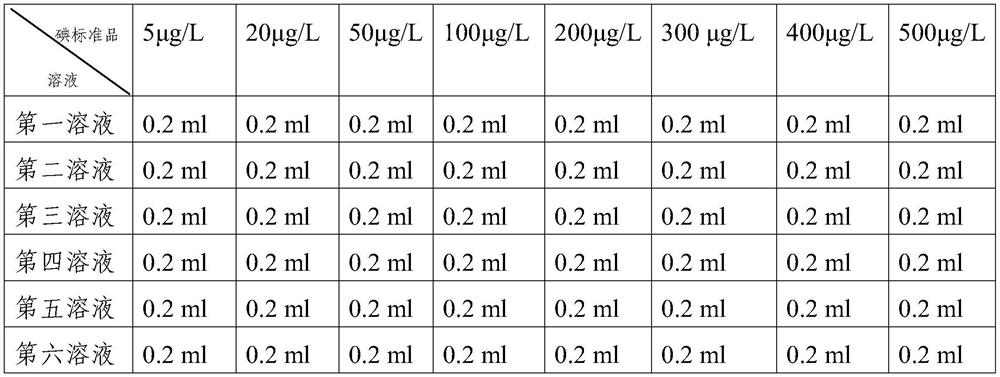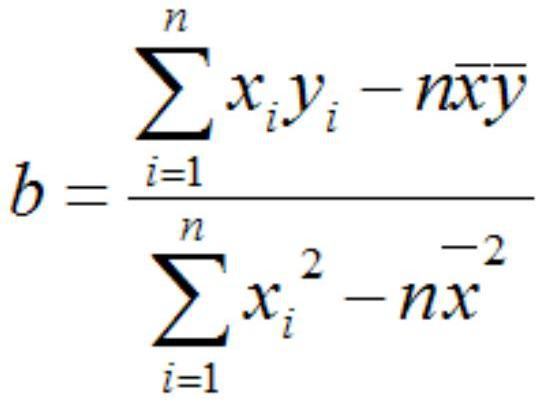Reagent, kit and detection method for quantitative detection of blood iodine
A quantitative detection and reagent technology, applied in measurement devices, material analysis, instruments and other directions by observing the impact on chemical indicators, can solve the problems of troublesome detection, low accuracy, and high detection cost, and achieve less sampling and accurate High rate and good repeatability
- Summary
- Abstract
- Description
- Claims
- Application Information
AI Technical Summary
Problems solved by technology
Method used
Image
Examples
Embodiment 1
[0076] This embodiment provides a reagent for quantitative detection of blood iodine, which includes
[0077] The first solution comprises 20% ammonium sulfate and 8% isopropanol according to mass percentage, and the balance is water;
[0078] The second solution comprises 4.0% sodium hypochlorite and 3.0% sodium chloride according to mass percentage, and the balance is water;
[0079] The third solution comprises 20% sulfuric acid and 3.0% hydrochloric acid in terms of mass percentage, and the balance is water;
[0080] The fourth solution includes 2.5% sodium chloride and 3.0% sodium arsenite in terms of mass percentage, and the balance is water;
[0081] The fifth solution comprises 3.0% ferrous sulfate, 0.2% o-phenanthroline and 2.0% sulfuric acid according to mass percentage, and the balance is water;
[0082] The sixth solution includes 0.2% cerium ammonium sulfate, 1.0% cerium sulfate and 1.5% sulfuric acid in terms of mass percentage, and the balance is water.
[00...
Embodiment 2
[0107] The difference between this embodiment and Example 1 is that the first solution includes 40% acetonitrile by mass percentage, and the balance is water; the second solution includes 7.0% sodium hypochlorite and 4.0% by mass percentage Sodium chloride, the balance is water; the third solution, according to mass percentage, includes 18% sulfuric acid and 4.0% hydrochloric acid, and the balance is water; the fourth solution, according to mass percentage, includes 2.5% sodium chloride and 5.0% sodium arsenite, the balance is water; the fifth solution, according to mass percentage, includes 2.0% ferrous sulfate, 0.5% o-phenanthroline and 5.0% sulfuric acid, and the balance is water; Sixth solution, according to mass percentage, it includes 0.7% cerium ammonium sulfate, 2.3% cerium sulfate and 3.0% sulfuric acid, and the balance is water. Others are all the same as in Example 1.
[0108] The calculation formula is obtained as y=7.7929x -1.2548 . According to the above calcu...
Embodiment 3
[0110] The difference between this embodiment and Example 1 is that the first solution includes 25% acetonitrile and 10% ethyl acetate in mass percent; or 20% ammonium sulfate and 8% isopropanol in mass percent; the second Solution, comprising mass percentage is 10% sodium hypochlorite and 5% sodium chloride; The third solution, comprising mass percentage is 15% sulfuric acid and 12% hydrochloric acid; The fourth solution, comprising mass percentage is 2% sodium chloride and 1% sodium arsenite; the fifth reagent, including 1.2% ferrous sulfate, 1.2% o-phenanthroline and 5% sulfuric acid in mass percent; the sixth solution, including 0.2% cerium sulfate in mass percent ammonium, 0.5% cerium sulfate and 5% sulfuric acid. Others are all the same as in Example 1.
[0111] The calculation formula is obtained as y=6.4067x -1.2378 . According to the above calculation formula, the reaction time of the first serum to be tested is respectively 37.999s, and the obtained y values are...
PUM
 Login to View More
Login to View More Abstract
Description
Claims
Application Information
 Login to View More
Login to View More - R&D
- Intellectual Property
- Life Sciences
- Materials
- Tech Scout
- Unparalleled Data Quality
- Higher Quality Content
- 60% Fewer Hallucinations
Browse by: Latest US Patents, China's latest patents, Technical Efficacy Thesaurus, Application Domain, Technology Topic, Popular Technical Reports.
© 2025 PatSnap. All rights reserved.Legal|Privacy policy|Modern Slavery Act Transparency Statement|Sitemap|About US| Contact US: help@patsnap.com



